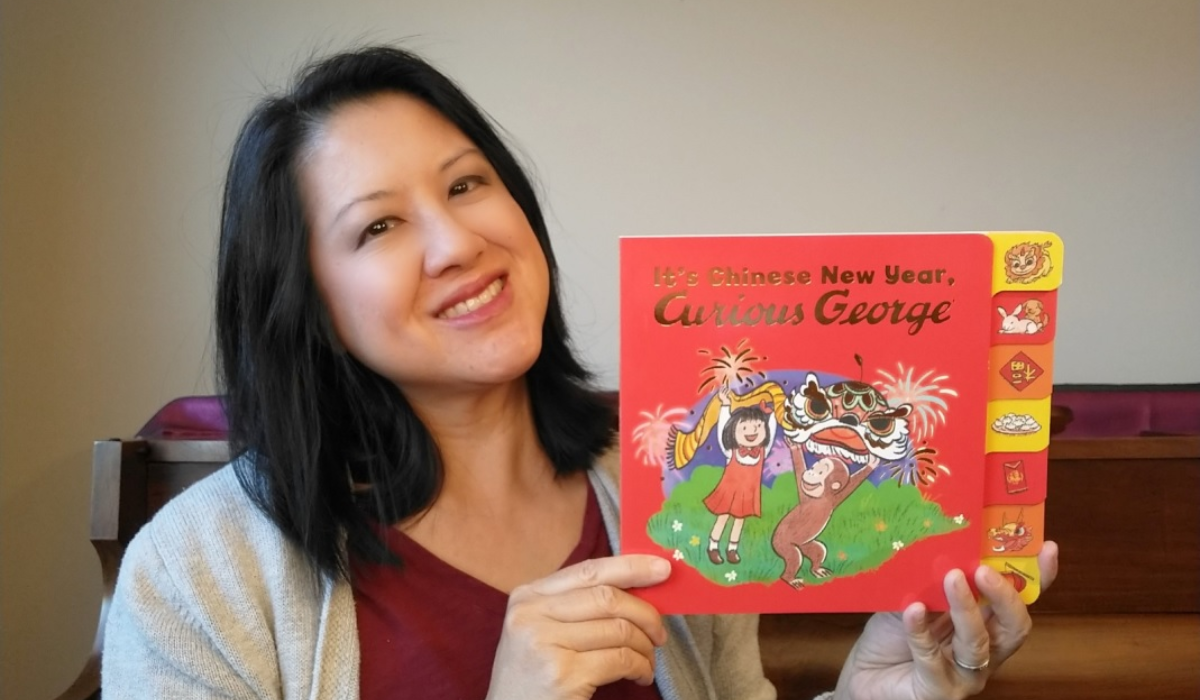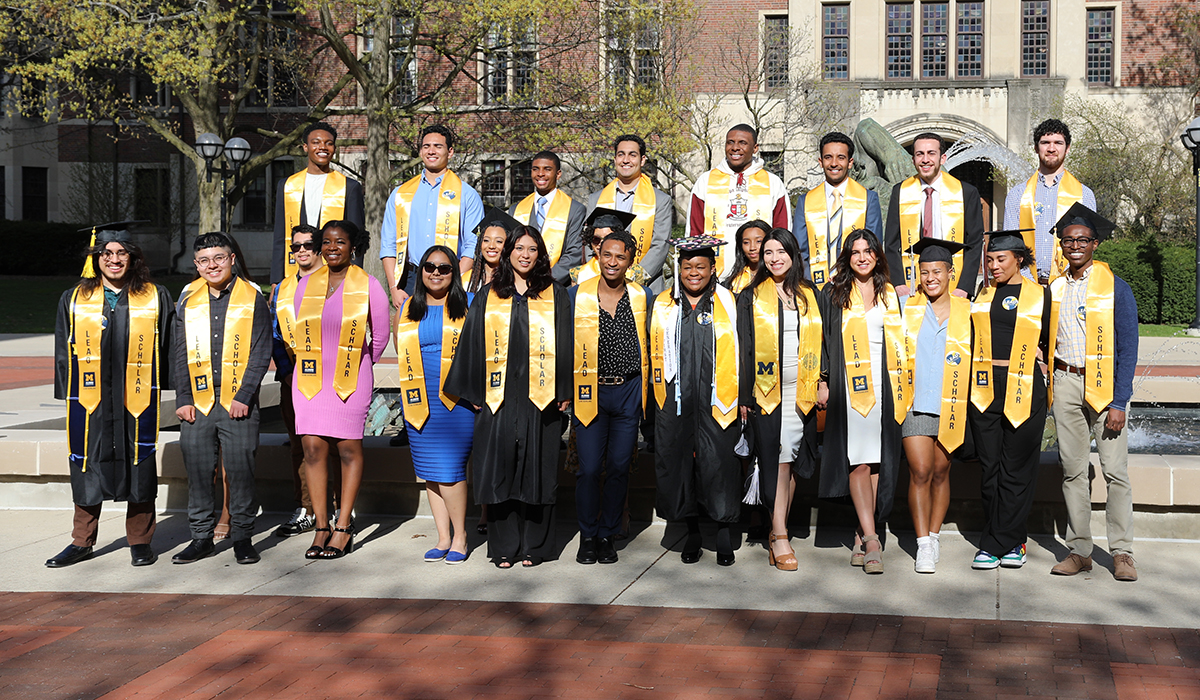Buckle up your backpack for a futuristic ride through U-M’s new world of cyber-learning.
Imagine being able to predict how students will perform in class and then helping them achieve more. Picture students learning policy development by acting as stakeholders in simulated political events. Envision an online platform that can mentor a whole new generation of civil rights leaders.
These are just a few of the educational tools coming out of U-M’s Office of Academic Innovation, a 3-year-old organization that is influencing the future of education with initiatives that have already reached 5.6 million learners around the globe.
Digital innovation has long been a Michigan forte, yet until the creation of this umbrella organization, there was no way to shepherd ideas across campus coherently. Now, through Academic Innovation, more than 150 faculty, some 50 student fellows, and 45 full-time staff are activating and fostering new ideas, using the entire University, and beyond, as its incubator.
James DeVaney, the associate vice provost of Academic Innovation, likes to say they are “reimagining what a public research university looks like” and asking themselves, “What is only possible at a place like the University of Michigan?”
According to U-M President Mark Schlissel, nearly everything.
“We can create a global-learning laboratory with size and scale that are truly staggering,” Schlissel said in January during the first-ever Harvesting Academic Innovation for Leaders conference. “Using digital modes of communication, we can also reach millions of learners across the full spectrum of society, no longer limited by geography or demographics.” U-M hosted the conference, dubbed the HAIL Storm, for close to 20 different academic institutions.
Schlissel’s enthusiasm was equally apparent at the March 13 opening of the Academic Innovation Forum on Broadening the University of Michigan Community—a two-day campuswide event that encouraged everyone to embrace digital technology and learning analytics. Ending with a “design jam,” students built prototypes for new digital learning platforms.
Below, we take you on a quick tour of Academic Innovation’s three collaborative labs and show some of its most cutting-edge learning and teaching projects. Many received funding from the Third Century Initiative—a five-year, $50 million program created in 2011 to develop innovative, multidisciplinary teaching and scholarship approaches. Academic Innovation also has partnerships with other academic technological platforms and projects, including Coursera, edX, and NovoEd.
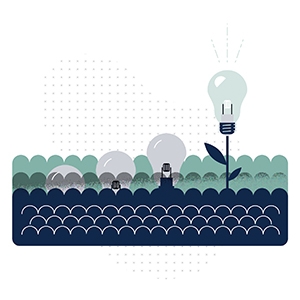
DIG IT
When professors want to develop new ideas for learning and educational prototypes, they turn to the Digital Innovation Greenhouse (DIG). DIG’s job is to create technology tools that help solve an educational problem for students. In short, the work of DIG’s team of software developers, designers, behavioral scientists, data scientists, and student fellows is providing students across campus with new digital instruments for success.
DIG came into existence with the development of a few early projects, including ECoach, which was created in 2012 by Tim McKay, a U-M physics and astronomy professor, who is now DIG’s faculty director. McKay wanted to solve a specific problem: a lack of interaction between students and professors in large undergraduate classes. “It is what it sounds like,” says Mike Daniel, DIG’s operational director, who also serves as the director of policy and operations at Academic Innovation. “It’s personalized coaching for each student.”
To use ECoach, students must enter demographic information about themselves and the grade they hope to receive in the class. The program then offers study prompts, time management tools, and advice based on what similar students have needed to do to achieve that same grade. It also provides a combination of personalized messages—from the professor, other students, and a behavioral scientist—to give students insight into their progress. During ECoach’s testing, students often earned one-third of a grade higher. Some 10,000 students are now using ECoach, which debuted on the U-M campus in the fall 2016 semester.
Similarly, M-Write was created to help personalize the teaching in some of the University’s larger courses, where writing has not been a big part of the learning experience. Anne Gere, director of the Sweetland Writing Center, and Ginger Schultz, a U-M assistant professor of chemistry, initiated M-Write believing that well-framed writing assignments could enhance students’ learning of the core content.
“If you can’t explain it, you don’t know it,” says Gere, who realized that many science, technology, engineering, and mathematics (STEM) students were having trouble in the class. “The way that these courses are taught is not very interesting conceptually. And the way that they’re assessed is multiple choice tests, and for someone like me who’s always cared about language, writing isn’t even in the picture.”
M-Write is a digital toolkit professors can utilize to help students who are having difficulty understanding conceptual material. The idea is that by reflecting and writing about key concepts in a class, the student’s level of understanding deepens. The program combines conceptual writing prompts and personalized feedback. Students receive both automated and peer assessments of their writing. So far, some 5,000 U-M students have used it in large introductory classes. The goal is to reach more than 10,000 students by 2021.
Gus Evrard, a U-M professor of physics and astronomy, is the creator of the Academic Reporting Toolkit, otherwise known as ART 2.0. Rolled out in March 2016, the interactive-software platform analyzes the demographic makeup of students in a particular class—giving clues to the majors and years of the students, along with the other classes they are currently taking. ART 2.0 might encourage a faculty member to teach a section of a class differently from another section because of the class’s characteristics. It might also motivate a student to sign up for courses already completed by peers in the class who are performing well.
So far, more than 9,000 courses are in the database. “The University is a giant ecosystem,” says Evrard. “You’ve got courses. You’ve got instructors. You’ve got students. How do we visualize the interactions of all of that?” ART 2.0 is now doing just that.
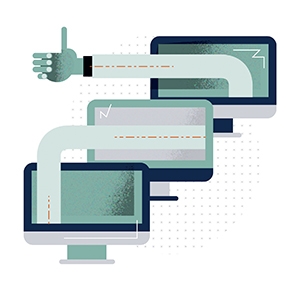
MOOC ME
The Digital Education and Innovation Lab (DEIL) is the campus resource for creating new digital courses, programs, and learning models. Established in 2014, DEIL’s job is to act as a collaborative hub for innovators, allowing faculty and staff to experiment with new technologies and pedagogies for learners of all ages, both on and off campus. Among other projects, DEIL builds U-M’s massive open online courses (MOOCs)—essentially online versions of classes, often with video lectures, that are open and accessible to anyone in the world, usually for no charge. To date, they are the best-known example of digital innovations at U-M and other universities.
Early on, MOOCs were hyped as the end of the physical university campus, a doomsday scenario that has not been borne out. Instead, they have created numerous cyber-learning opportunities. U-M currently offers, or is developing, about 100 MOOCs taken by about 5.6 million students, 70 percent of whom are outside the U.S. Courses range from subjects like “Introduction to Finance” to “Inspiring and Motivating Arts and Culture Teams.”
In short, MOOCs cover a broad range of disciplines, including complex social topics that are especially popular with international students, who might not have access to the information in their own countries. Take the MOOC titled “AIDS: Fear and Hope”; only 21 percent of the students were from the U.S., with the remainder being from India, Mexico, and China.
To create MOOCs, DEIL works with faculty on curricular innovations. DEIL staff includes project managers, instructional-media specialists, and learning-experience designers. “This is a place where people can come to workshop ideas and move the needle of academic innovation,” says Noni Korf, director of DEIL. She adds that big-topic MOOCs, like the course on AIDS, are “projects that we really like to engage with because you kind of shake them up and think about them.”
MOOCs have also created an opportunity to collect and analyze millions of data points about everything from student behavior to the demographics of a class. By learning about these students, professors can “think about different modifications to the curriculum that would lead to a more inclusive, harmonized campus,” says DeVaney, the associate vice provost of Academic Innovation. They can also experiment and adapt the material to fit different types of learners.
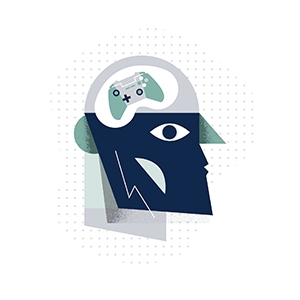
GAME ON
Before the Gameful Learning Lab (GLL), who would have thought video gaming could be a model for teaching curriculum? Thanks to GLL, which came to life in 2016, combining game mechanics and learning analytics is proving to have an effect on both student motivation and achievement.
“In gameful learning, mastery comes from trying different digital pathways designed in a gaming style, with grades building from zero, rather than down from 100,” says Rachel Niemer, GLL’s director and founder. The hope is that students will see that “putting in effort and learning from your mistakes actually leads to greater competence.”
In designing gameful classes, Niemer says her staff looks at what goes “into creating a game that people play because it is hard, not despite it being hard.” Games provide context and stories, keeping players involved even when the material is difficult, which is exactly when students in traditional classes often tune out. By making learning more fun, like a game, students might become more engaged in their goals and advance to the next level.
GradeCraft—a gameful-learning management system—is now piquing students’ curiosity. Initially created as a class project by Caitlin Holman, a doctoral student in the School of Information, with the help of Barry Fishman, a U-M professor in the School of Information and School of Education, it was introduced on campus in 2012.
Using gaming strategies, the GradeCraft website is designed to motivate and engage students. A professor using GradeCraft to teach a course creates the curriculum around any point system that works. Students can then earn points, for example, for everything from in-person attendance (5,000 points per class) to completing individual reading and writing assignments (another 5,000 each). Students can track their progress with the “grade predictor,” which shows how many points are needed to attain an “A” in the class. To hit that high level, professors offer optional assignments. In one course, for instance, students can earn an extra 2,500 points a week by writing a scholarly blog post for the class referencing a topic discussed in that week’s lecture. The website is visually playful, with points tallied weekly and badges earned. So far, nearly 7,000 students in more than 70 U-M courses have used GradeCraft.
Gaming, of course, is just one way Academic Innovation is looking at the future of learning. Like any field, it is impossible to predict where all this research and development will end up, says DeVaney. “We’ve made a lot of progress in just a few short years in taking the considerable expertise at the University and delivering it to different kinds of learners. And because we’re driven by a mode of experimentation, we’re quickly building on each subsequent initiative.”
CYBER SCHOOL CLASSES
Following is a sampling of some of the educational tools and platforms Academic Innovation has helped create for students on and off campus.
THE YOUTH CIVIL RIGHTS ACADEMY
The interactive-digital portal allows high school-age participants and youth—regardless of their geography, race, ethnicity, or socioeconomic status—to learn about their rights in a modern-day context. Students also are able to share their stories and experiences, and discover resources for effecting change. The goal is to prepare a new generation of school and community leaders to promote civil rights, while expanding equal opportunities statewide. Led by Professor Barry Checkoway of U-M’s School of Social Work, the academy is a collaborative project with the Michigan Department of Civil Rights and the Michigan Department of Education.
MICROMASTERS
MicroMasters is an accelerated pathway to U-M’s resident master’s programs that allows online students from around the world to take a series of MOOCs in a particular field. Students who choose this option take only the online classes and receive a certificate. Its larger intent is to allow prospective students to test programs and take classes online in preparation for a full master’s program on campus. MicroMasters allows for greater diversity among students and saves prospective students money when used in conjunction with a full degree. The first course of a fall 2016 School of Information MicroMasters on “User Experience Research and Design” enrolled 45,000 students, roughly the same number of students on the entire Ann Arbor campus.
POLICYMAKER
Policymaker is a platform, still in development, that supports faculty in creating and implementing simulations in a classroom. It lets students act as stakeholders in a political event, allowing for the simulation of an event or policy initiative, such as a legislature debating new laws. Students may send messages to each other via the platform, which allows them to understand and experience strategy development, collaboration, advocacy, and communication, while gaining an appreciation of the complexity of the processes behind policy development. Elisabeth Gerber, a professor in the Ford School of Public Policy, created the platform.
Michael Luongo is an award-winning freelance journalist. He was a 2015-16 Knight-Wallace Journalism Fellow and a fall 2016 English department lecturer.




